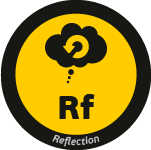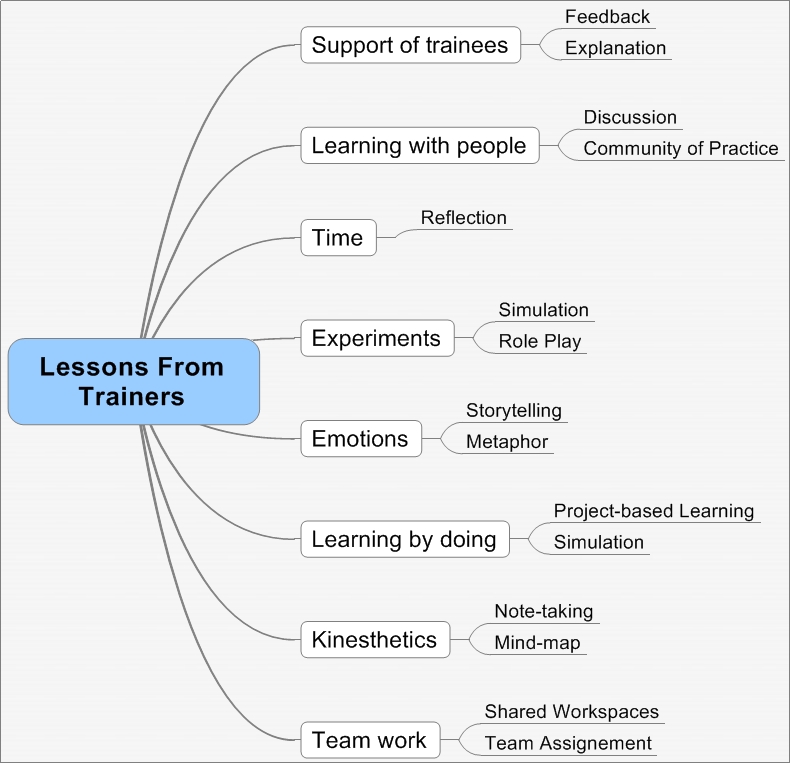What eLearning Designers Should Learn From Trainers
A traditional trainer creates some kind of magic. In the stage of a training room the trainer has a vast portfolio of activities (training methods) which can be used to engage, motivate, make trainees curious, create "aha" moments, let trainees be together, etc. Skillful trainers dynamically mix and match all of these methods to deliver training goals - so the traditional training rarely looks the same as every training group is different.
The problem with typical eLearning courses is that they don't have such dynamics as workshops. eLearning providers usually offer static material for self-learning. Instead of magic, trainees are given a set of screens with a [Next] button.
Very often we forget that both the trainee and the eLearner are the same person - with the same abilities, motivations, attitudes. They expect to be provided with a learning experience of the same "power". Traditional training and eLearning don't have to be founded on the same principles - but they both have to be magical.
How to bring moments of magic to the eLearning course? Let's discuss 8 ideas. They will not cover all possibilities (e.g. I will not elaborate on games which is a quite obvious mechanism of building magic) - I would rather focus on these which are usually neglected.
1. Support of trainees

 During traditional training a trainee is supported on various levels. He/she can count on the support from the trainer, from the co-learners, from the manager (mentor). The eLearner was used to be left by themselves.
During traditional training a trainee is supported on various levels. He/she can count on the support from the trainer, from the co-learners, from the manager (mentor). The eLearner was used to be left by themselves.
Withing eLearning processes we should support eLearners. We can provide to them ways of communication with a subject matter expert; we can provide to them channels of remote interaction with a trainer. We can explain things. We can connect a trainee with a trainer or a mentor. eLearning courses don't have to leave the eLearner alone with a computer - they should build communication bridges between these who don't know and these who know.
We also have to provide a very good feedback to all learning moments. This feedback could be delivered not only automatically (by interactive mechanisms of the eLearning course) but personally (by a trainer or a mentor) as well.
2. Learning with people

 During traditional training people interact with each other. They discuss, share ideas, socialize. A typical eLearning course doesn't provide such important forms of building competencies.
During traditional training people interact with each other. They discuss, share ideas, socialize. A typical eLearning course doesn't provide such important forms of building competencies.
eLearning space gives many possibilities of reinforcing peer-to-peer learning. OK - it is hard to introduce discussion to the eLearning course but we can open such a discussion environment just outside of it (eg. in the eLearning platform). We can create a community of practice environment and give the eLearner a task to use it with a defined learning goal. Such a task, as well as participation in the threaded discussion, should be evaluated by a trainer and a feedback should be given to make these mechanisms as effective as possible (Support of Trainees rule).
3. Time
 Traditional learning gives trainees time - time to reflect, time to discuss, time to practice, etc. eLearning courses very rarely give time. eLearners usually have strict deadlines and they are expected by their managers to consume as little time as possible to click through the eLearning course.
Traditional learning gives trainees time - time to reflect, time to discuss, time to practice, etc. eLearning courses very rarely give time. eLearners usually have strict deadlines and they are expected by their managers to consume as little time as possible to click through the eLearning course.
Let's give eLearners time. While designing the eLearning process we have to provide the time for reflection between eLearning modules. We also have to provide the time within every single eLearning module. We can suggest a time for reflection on a certain topic; we can suggest to write or draw something, or maybe to create a mind-map. We can suggest to stop the eLearning course for a moment and ask a colleague for a 3-minute discussion. It will not only give the eLearner the time, but it will also connect him/her with other people (Learning with People rule).
4. Experiments

 One of the most important elements of training adults is giving them a chance to experiment (Kolb's Cycle). Such experiments are often part of traditional training. This approach could also be used in the eLearning space. It will create a truly engaging learning environment.
One of the most important elements of training adults is giving them a chance to experiment (Kolb's Cycle). Such experiments are often part of traditional training. This approach could also be used in the eLearning space. It will create a truly engaging learning environment.
We can let people experiment by simulating things in the eLearning course. We can provide soft-skills training by letting eLearners play roles. Let's make them experience simulated situations - with a difficult client, with a layed-off employee, or with a very assertive colleague. Such experiments should be concluded with a very good feedback (Support of Trainees rule) building space for a good reflection (Time rule).
5. Emotions

 A skillful trainer brings a lot of great emotions to the training room. Well-prepared eLearning courses should provide them as well.
A skillful trainer brings a lot of great emotions to the training room. Well-prepared eLearning courses should provide them as well.
People like to hear stories. A trainer is aware of such a need and tells a lot of stories, summarizes cases and his/her experiences, tells anecdotes. While designing eLearning courses we should use these learning forms as well. We can use texts to tell stories, we can visualize them with pictures or drawings (digital storytelling), we can use movies, etc.
Emotions are also being built by using metaphors. They not only create vivid, emotional pictures in trainees' minds, but also effectively encode information in their brains. Emotions are also being created by the deliberate use of multimedia (visuals, pictures, narrations, etc).
6. Learning by doing

 According to the 70:20:10 theory, the majority of our competencies is being built by doing things. eLearning solutions could be also used to support this model of learning.
According to the 70:20:10 theory, the majority of our competencies is being built by doing things. eLearning solutions could be also used to support this model of learning.
The eLearning course itself gives only a limited number of such possibilities. Of course we can use simulations and role plays (Experiments rule) in it - but as eLearning designers we have much more chances to reinforce learning by doing outside of the course. We can use implementation tasks (tasks to be done in the workplace and support implementation of a new competence), we can recommend to deliver a project (personally or as a team), we can recommend to practice new competencies with a set of proposed experiments concluded with a self-reflection (Experiments and Time rule).
7. Kinesthetics

 Many people like to play with things. Such kinesthetic needs are easily met in the training room - trainees can play with a workbook, doodle in their notepad, create mind-maps, take notes, play with a pencil. An eLearning course gives some kind of a kinesthetic experience (we can click, interact with objects, solve quizzes, etc.), but usually it is a closed sandbox providing a limited number of routine activities.
Many people like to play with things. Such kinesthetic needs are easily met in the training room - trainees can play with a workbook, doodle in their notepad, create mind-maps, take notes, play with a pencil. An eLearning course gives some kind of a kinesthetic experience (we can click, interact with objects, solve quizzes, etc.), but usually it is a closed sandbox providing a limited number of routine activities.
As eLearning course designers we can open the space of kinesthetic experiences. eLearners, during the eLearning process, shouldn't be limited by a space of a computer or a monitor. On the last screen of an eLearning course we can suggest to prepare a mind-map about the learning module and save it for future reference. In the product course we can recommend to design an infographic about its specification. Or to prepare notes about the course and discuss them with a colleague or supervisor (Learning with People rule).
8. Teamwork

 People feel motivated by working and learning with other people. Such a motivation is being heavily used by a trainer during a workshop - trainees compete or cooperate with each other while being engaged in various tasks and challenges. How to transfer this idea to the eLearning world where eLearners usually consume eLearning content individually?
People feel motivated by working and learning with other people. Such a motivation is being heavily used by a trainer during a workshop - trainees compete or cooperate with each other while being engaged in various tasks and challenges. How to transfer this idea to the eLearning world where eLearners usually consume eLearning content individually?
Well - new technologies bring new opportunities here. We can open a shared workspace environment and ask eLearners to deliberately use it with a goal of creating something. We can provide team assignments - ask eLearners to gather in teams and to prepare a project (Learning by Doing rule). Rules of these activities should be communicated within the eLearning course, but located outside of it. Such a teamwork could be gamified and should be evaluated by a trainer or mentor (Support of Trainees rule).


